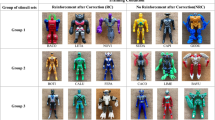Abstract
The present study evaluated the effectiveness of using positive practice over-correction in combination with other techniques to teach two manual signs (“milk” and “cookie”) to an autistic boy. This boy had a great deal of difficulty informing any type of discrimination and often became confused in learning the most simple simultaneous discrimination. Intervention primarily consisted of positive practice overcorrection in which the subject was physically guided to form a required hand sign 10 times when he responded incorrectly and was positively reinforced when he signed correctly. The study used a changing criterion within a multiple-baseline design across responses. The results indicated that overcorrection plus positive reinforcement was effective in teaching one sign (milk), however, and added contingent exercise (having to stand up and sit down 10 times for an incorrect response) was required to teach the second sign (cookie). Once the two signs were learned to a criterion level, it was a relatively easy task for the subject to respond correctly with the signs in a matching-to-sample task.
Similar content being viewed by others
Reference note
Creedon, M.Language development in nonverbal autistic children using a simultaneous communication system. Paper presented at the Society for Research in Child Development, Philadelphia, 1973.
References
Azrin, N. H., & Holz, W. C. Punishment. In W. A. Honig (Ed.),Operant behavior: Areas of research and application. New York: Appleton-Century-Crofts, 1966. Pp. 380–447.
Azrin, N. H., & Wesolowski, M. D. Eliminating habitual vomiting in a retarded adult by positive practice and self-correction.Journal of Behavior Therapy and Experimental Psychiatry, 1975,6, 145–148. (a)
Azrin, N. H., & Wesolowski, M. D. The use of positive practice to eliminate persistent floor sprawling by a profoundly retarded person.Behavior Therapy, 1975,6, 627–631. (b)
Barrera, R. D., Lobato-Barrera, D., & Sulzer-Azaroff, B. A simultaneous treatment comparison of three expressive language training programs with a mute autistic child.Journal of Autism and Developmental Disorders, 1980,10, 21–37.
Bonvillian, J. D., & Nelson, K. E. Sign language acquisition in a mute autistic boy.Journal of Speech and Hearing Disorders, 1976,61, 339–347.
Carr, E. G. Teaching autistic children to use sign language: Some research issues.Journal of Autism and Developmental Disorders, 1979,9, 345–359.
Casey, L. O. Development of communicative behavior in autistic children: A parent program using manual signs.Journal of Autism and Childhood Schizophrenia, 1978,8, 45–59.
Fulwiler, R. L., & Fouts, R. S. Acquisition of American Sign Language by a noncommunicating autistic child.Journal of Autism and Childhood Schizophrenia, 1976,6, 43–51.
Hewett, F. Teaching speech to an autistic child through operant conditioning.American Journal of Orthopsychiatry, 1965,35, 927–936.
Kanner, L. Autistic disturbance of affective contact.Nervous Child, 1943,2, 217–250.
Lovaas, O. I., Berberich, J. P., Perloff, B. F., & Schaeffer, B. Acquisition of imitative speech in a schizophrenic child.Science, 1966,151, 705–707.
Lovaas, O. I., Koegel, R. L., & Schreibman, L. Stimulus overselectivity in autism: A review of the research.Psychological Bulletin, 1979,86, 1236–1254.
Luce, S. S., Delguardi, J., & Hall, R. V. Contingent exercise: A mild but powerful procedure suppressing inappropriate verbal and aggressive behavior.Journal of Applied Behavior Analysis, 1980,13, 583–594.
Rutter, M. Language disorder and infantile autism. In M. Rutter & E. Schopler (Eds.),Autism: A reappraisal of concepts and treatment New York: Plenum, 1978.
Salvin, A., Routh, D. K., Foster, R. E., Jr., & Lovejoy, K. M. Acquisition of modified American Sign Language by a mute autistic child.Journal of Autism and Childhood Schizophrenia, 1977,7, 359–371.
Walker, G., Hinerman, P., Jenson, W. R., & Petersen, B. Sign language as a prompt to teach a difficult “Yes” and “No” discrimination to an autistic boy.Child Behavior Therapy, in press.
Wing, L.Autistic children: A guide for parents and professionals. Secaucus, New Jersey: Citadel Press, 1979.
Author information
Authors and Affiliations
Rights and permissions
About this article
Cite this article
Hinerman, P.S., Jenson, W.R., Walker, G.R. et al. Positive practice overcorrection combined with additional procedures to teach signed words to an autistic child. J Autism Dev Disord 12, 253–263 (1982). https://doi.org/10.1007/BF01531371
Issue Date:
DOI: https://doi.org/10.1007/BF01531371




